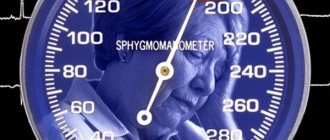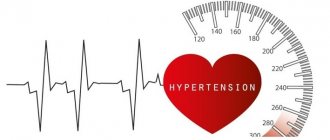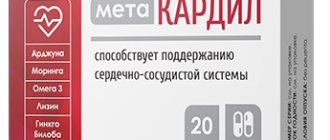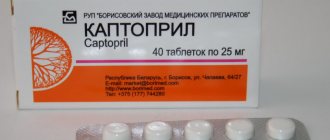Captopril is a drug from the group of ATP inhibitors, which was created back in 1973. Until now, it has been successfully used by patients with signs of hypertension and heart disease. Often, hypertensive patients ask doctors questions at what pressure to take Captopril, what are the advantages of this drug over other antihypertensive drugs, how effective are the tablets and whether they can provide emergency help with high blood pressure. Therefore, today we will talk about the drug Captopril, we will talk about its use, indications, side effects and other nuances of treating hypertension with this drug.
When should you take Captopril?
Captopril tablets for high blood pressure are taken on the recommendation of the attending physician, who also selects the required dosage and frequency of use of the drug. According to the instructions for use, the use of Captopril is justified not only for the treatment of hypertension, but also for other concomitant diseases:
- high blood pressure and hypertension, including those forms that cannot be treated with other types of medications;
- chronic hypertension, aggravated by regular surges in blood pressure, heart failure and angina pectoris;
- pathologies associated with impaired renal vascular function;
- ambulance for relief of hypertensive crisis;
- renoparenchymal hypertension due to recent or chronic glomerulonephritis;
- bronchial asthma, accompanied by a regular increase in blood pressure;
- renal vascular pathologies resulting from diabetes mellitus;
- chronic heart failure that cannot be treated with cardiac glycosides and diuretics;
- Conn's syndrome.
Many patients take Captopril for high blood pressure only when there are sudden changes and signs of a hypertensive crisis, which is fundamentally wrong. Hypertension should be treated systematically, combining medications prescribed by the doctor with moderate physical activity, diet and physiotherapy.
As a result, such patients belong to the group of people who independently increase the risk of developing strokes, myocardial infarction and shorten their own lives by several years
Dangerous symptoms
An elderly woman with a severe headache.
Photo: dusanpetkovic / freepik.com Some people have asymptomatic increases in blood pressure, but in most cases the following signs are observed:
- weakness and fatigue,
- pressing or throbbing headache in the occipital and/or temporal part,
- nausea,
- dizziness,
- chest pain,
- noise in ears,
- shortness of breath during habitual physical activity,
- numbness of the limbs,
- blurred vision, flashing spots before the eyes,
- irritability,
- increased sensitivity to light (sometimes to sounds).
The appearance of even one or two of the symptoms listed above should be a cause for concern. Some people prefer to simply “endure” an episode of high blood pressure “so as not to be poisoned by all this chemistry” (that is, pills). But such manifestations cannot be ignored, since, as we said above, high blood pressure is fraught with a number of dangerous consequences.
Advantages of the drug
Why is the drug Captopril considered very effective for the treatment of hypertension and heart failure? This is explained by a number of undeniable advantages over similar drugs:
- according to studies, the mortality rate from diseases of the cardiovascular system with regular use of Captopril is significantly reduced;
- the drug lowers blood pressure as effectively as other drugs from the main classes intended to relieve symptoms of hypertension;
- does not pose a danger to elderly patients;
- slows down the development of symptoms of kidney diseases, even those arising against the background of diabetes mellitus;
- does not reduce erectile function in men;
- acts on the body as a whole, providing an antioxidant effect on tissues and blood vessels;
- reduces the risk of malignant tumors many times more effectively than other classes of medications.
In addition to the listed advantages of using Captopril in the treatment of hypertension, the drug is affordable, in contrast to analogues and products with a similar chemical composition. Therefore, patients and doctors have long considered Captopril to be the gold standard in the treatment of hypertension, high blood pressure and pathologies of the cardiovascular system.
Diet
It is necessary to limit the consumption of salt and foods rich in sodium (fatty meat, seafood, eggs). Alcohol, coffee and energy drinks are also not recommended for consumption. The diet should be enriched with plant fiber and low-fat lactic acid products. It is also necessary to consume more foods rich in potassium (bananas, spinach, garlic).
People with high blood pressure are advised to eat more vegetables and fruits. Photo: prostooleh / freepik.com
Lifestyle
It is strongly recommended to quit smoking. You need to learn to avoid stress and sleep at least 8 hours a day. To strengthen the cardiovascular system, you need to engage in moderate physical activity, since physical inactivity is one of the factors predisposing to the disease. In addition, physical activity combined with a healthy diet helps normalize body weight. This is a relevant question because overweight people are predisposed to hypertension. Nasal sprays should be used with caution - they increase blood pressure (not to mention the ability to cause addiction). It is recommended to take dietary supplements such as L-carnitine, hawthorn extract, coenzyme Q10 and fish oil.
At what pressure will the drug be effective?
Captopril for blood pressure has an effect on ACE (angiotensin-converting enzyme), which affects the tone of blood vessels, narrowing them and causing an increase in blood pressure. As a result, the capillary walls maintain normal tone, do not contract and do not slow down blood circulation. With constant use of the medicine, you can reduce blood pressure to normal levels and maintain it within acceptable limits.
Captopril quickly reduces blood pressure, improving blood supply to the heart, relaxing its capillaries and reducing the load on the myocardium. At the same time, the heart muscle retains its full ability to pump a sufficient amount of blood into the circulatory system. Patients who take Captopril after a heart attack are able to withstand physical stress and emotional stress because their heart muscle becomes more resilient.
It is important to reduce blood pressure gradually
At what pressure should you take the tablets so that they have the maximum therapeutic effect? Captopril is usually prescribed to patients diagnosed with the first and second stages of hypertension, when blood pressure levels rise to 179/109. This condition does not require additional therapy and can be easily treated with the prescribed dose of tablets. Severe hypertension, in which the pressure rises above 180/110, requires the use of the drug together with diuretics, since in such situations Captopril does not reduce the pressure to normal levels alone.
Pharmacological properties of the drug Captopril
Pharmacodynamics . Captopril is the first synthetic ACE inhibitor. By blocking the conversion of angiotensin I to angiotensin II, it has a vasodilating effect, thereby reducing peripheral vascular resistance (afterload), wedge pressure in the pulmonary capillaries (preload) and pressure in the pulmonary vessels; increases IOC and exercise tolerance. With long-term use, captopril reduces the severity of left ventricular myocardial hypertrophy. Reduces the tone of the efferent arterioles of the glomeruli of the kidneys, thereby improving intraglomerular hemodynamics and preventing the development of diabetic nephropathy. Pharmacokinetics . When taken orally, the drug is quickly and almost completely (at least 75%) absorbed into the gastrointestinal tract. In the presence of food, bioavailability is reduced by 30–40%. The maximum concentration in blood plasma is reached after 30–90 minutes. Protein binding, predominantly albumin, is 25–30%. Penetrates through histohematic barriers, including the blood-brain barrier, and crosses the placenta. Metabolized in the liver. The half-life is less than 3 hours and increases with renal failure. It is excreted mainly by the kidneys in the form of metabolites and unchanged (up to 50%). Within 24 hours, up to 25% of the drug is eliminated. The maximum decrease in blood pressure after taking the drug orally is observed after 60–90 minutes. The duration of the hypotensive effect is dose-dependent and reaches optimal values within several weeks.
Reception scheme
The effect of using Captopril directly depends on the prescribed regimen; it is necessary to take the tablets correctly in order to achieve the maximum therapeutic effect. According to the instructions from the manufacturers of the drug, patients with chronic heart failure need to take Captopril 6.25 mg up to three times a day. After 10–14 days, the dosage can be gradually increased.
After the first dose of the medicine has been taken, the patient needs to monitor blood pressure levels, measuring it every half hour for 2.5–3 hours to assess the effect of the tablets on the body. The average dosage for people with heart problems is 25 mg three times a day. To lower blood pressure, patients with hypertension need to take Captopril 12.5 mg in three doses or 25 mg twice a day.
The doctor can prescribe the best dose and frequency of administration after an examination. The maximum dose of the drug that a hypertensive patient can take during the day is 150 mg, divided into three doses (50 mg at a time). If a patient takes an increased dose of medication as an emergency treatment for a jump in blood pressure, this will not give the desired effect, but will only increase the risk of side effects. Patients with kidney disease are recommended to take the drug up to 75–100 mg per day; if necessary, the doctor uses loop diuretics.
In this case, treatment begins with an initial dosage of 6.25 mg three times a day, then, monitoring intermediate test results, the dosage is gradually increased.
Captopril Stada 25 mg No. 30 tablet.
Instructions for medical use of the drug Captopril STADA Trade name Captopril STADA International nonproprietary name Captopril Dosage form Tablets 12.5 mg, 25 mg and 50 mg Composition One tablet contains the active substance - captopril 12.5 mg, 25 mg or 50 mg, excipients : lactose monohydrate, pregelatinized corn starch, microcrystalline cellulose, stearic acid. Description Tablets are round in shape, with a flat surface, white, with a score line on both sides (for a dosage of 12.5 mg). Tablets are round in shape, with a flat surface, white, with a cross-shaped score on both sides (for dosages of 25 mg and 50 mg). Pharmacotherapeutic group Drugs affecting the renin-angiotensin system. Angiotensin converting enzyme (ACE) inhibitors. Captopril. ATC code C09AA01 Pharmacological properties Pharmacokinetics After oral administration, captopril is rapidly absorbed. The maximum concentration in the blood is reached after approximately one hour. Minimum absorption is about 75%. The presence of food in the digestive tract reduces absorption by approximately 30–40%. Binding to blood plasma proteins is about 25–30%. Peak plasma concentrations are reached after 60-90 minutes. The half-life is approximately 2 hours. More than 95% of the absorbed dose of captopril is excreted in the urine within 24 hours, of which 40-50% unchanged and 50-60% in the form of inactive disulfide metabolites (captopril disulfide and captopril cysteine disulfide). Decreased renal function may lead to drug accumulation. Therefore, in patients with reduced renal function, the dosage should be reduced and/or the dosing interval extended. Captopril does not penetrate the blood-brain barrier. Pharmacodynamics Captopril is an angiotensin-converting enzyme inhibitor. Inhibition of angiotensin-converting enzyme (ACE) leads to a decrease in the formation of angiotensin-II in the blood plasma, which has a vasoconstrictor effect, in tissues and blood plasma, resulting in a decrease in the secretion of aldosterone in the adrenal glands. As a result, diuresis and sodium excretion increase, the level of potassium in the blood serum increases, and water metabolism is normalized. The absence of the negative feedback reaction of angiotensin-II on renin secretion leads to an increase in renin activity in the blood plasma. Also, angiotensin-converting enzyme destroys bradykinin to inactive metabolites. ACE inhibition leads to increased activity of the circulating and local kallikrein-kinin system, which promotes peripheral vasodilation by activating the prostaglandin system. This mechanism is involved in the hypotensive effect of ACE inhibitors. In patients with arterial hypertension, captopril leads to a decrease in blood pressure in the horizontal and vertical position, without causing an increase in heart rate, sodium and water retention. In most patients, the hypertensive effect is observed 15-30 minutes after captopril administration. The maximum reduction in blood pressure is usually achieved after 60-90 minutes. It may take several weeks to achieve maximum therapeutic effect. The maximum reduction in blood pressure for a given dose of captopril is observed after 3-4 weeks of therapy. The blood pressure-lowering effects of captopril and thiazide diuretics are additive. Captopril causes a significant decrease in peripheral arterial resistance. In this case, there are no clinically significant changes in renal blood flow and glomerular filtration rate. When taking the recommended daily dose, the antihypertensive effect persists even with long-term therapy. Short-term discontinuation of captopril does not lead to a rapid, excessive increase in blood pressure (rebound). The use of captopril causes a decrease in left ventricular hypertrophy. In patients with heart failure, captopril reduces peripheral systemic resistance and increases venous capacity. This leads to a decrease in cardiac pre- and afterload (decreased left ventricular filling volume). During treatment with captopril, there is an increase in cardiac output, cardiac performance index and exercise tolerance. Indications for use - arterial hypertension - chronic heart failure (as part of complex therapy) Method of administration and dosage The dose of Captopril STADA is selected individually depending on the patient's condition and blood pressure response. The recommended maximum dose is 150 mg. Arterial hypertension The recommended initial dose is 12.5 mg 2 times a day. The dose may be increased gradually at intervals of at least 2 weeks, up to 100-150 mg per day, divided into two doses, as necessary to achieve the desired blood pressure. Captopril may be used alone or in combination with other antihypertensive drugs, especially thiazide diuretics. A once-daily dosing regimen may be sufficient with the addition of concomitant antihypertensive medications such as thiazide diuretics. In patients with a very active renin-angiotensin-aldosterone system (hypovolemia, renovascular hypertension, cardiac decompensation), it is preferable to start with a single dose of 6.25 mg or 12.5 mg. It is preferable to initiate such therapy under close medical supervision. These dosages will then be taken twice a day. The dose may be gradually increased to 50 mg per day in one or two divided doses and, if necessary, up to 100 mg per day in one or two divided doses. Heart failure Treatment of heart failure with captopril should be initiated under close medical supervision. The usual starting dose is 6.25 mg or 12.5 mg two or three times daily. Titration of the maintenance dose (75-150 mg per day) should be based on patient response, clinical status, and tolerance, to a maximum dose of 150 mg per day, divided into two divided doses. The dose should be increased gradually at intervals of at least 2 weeks to assess the patient's response. Dosage in elderly patients (over 65 years of age) The recommended starting dose is 6.25 mg 2 times a day. To achieve sufficient control, the dose should be titrated according to blood pressure response and kept as low as possible. Reduced renal function Recommended daily doses for patients with reduced renal function: Creatinine clearance (ml/min/1.73 m2) Initial daily dose (mg) Maximum daily dose (mg) >40 21-40 10-20 <10 25-50 25 12.5 6.25 150 100 75 37.5 The dosing interval should be increased. If it is necessary to prescribe concomitant diuretic therapy to patients with severe renal failure, preference is given to loop diuretics (furosemide) rather than thiazide ones. Dosage in children The use of Captopril STADA in children and adolescents 18 years of age and younger is not recommended, because The effectiveness and safety of captopril have not been fully established. Directions for use: Captopril STADA can be used before, during and after meals. Side effects - nausea, vomiting, stomach irritation, abdominal pain, anorexia, diarrhea, constipation, dry mouth, stomatitis / aphthous ulcerations, glossitis, peptic ulcers, pancreatitis - dry, non-productive cough, dyspnea, bronchospasm, rhinitis, allergic alveolitis / eosinophilic pneumonia, chest pain - itching with or without rash, rash, alopecia, angioedema, urticarial rash, Stevens-Johnson syndrome, erythema multiforme, photosensitivity, erythroderma, pemphigoid reaction, exfoliative dermatitis - decreased taste, dizziness, drowsiness, fatigue, malaise, fever, headache, paresthesia, cerebrovascular disorders (stroke, syncope), sleep disturbances, confusion, depression, visual disturbances - tachycardia or tachyarrhythmia, angina pectoris, hypotension, Raynaud's syndrome, flushing, pallor, cardiac arrest, cardiogenic shock - renal failure, polyuria, oliguria, frequent urination, proteinuria, nephrotic syndrome - decreased liver function, cholestasis, jaundice, hepatitis, necrosis of liver cells, increased liver enzymes and bilirubin - increased potassium, decreased sodium in blood plasma, increased residual urea nitrogen, serum creatinine and bilirubin, decreased hemoglobin, hematocrit, leukocytes, platelets in the blood, positive titers for antinuclear antibodies, proteinuria, eosinophilia, accelerated ESR - myalgia, arthralgia - impotence, gynecomastia Contraindications - hypersensitivity to captopril or another angiotensin-converting enzyme inhibitor in history - hypersensitivity to any component of the drug - vascular edema associated with a history of previous ACE inhibitor therapy - hereditary / idiopathic angioedema - second and third trimester of pregnancy - lactation Drug interactions ACE inhibitors reduce potassium losses caused by diuretics. Potassium-sparing diuretics (spironolactone, triamterene, amiloride), potassium supplements and potassium-containing salt substitutes can lead to a significant increase in plasma potassium levels. If, when hypokalemia is detected, the simultaneous use of such drugs with Captopril STADA is indicated, they should be used with caution and frequently monitor the level of potassium in the blood plasma. When using loop or thiazide diuretics with Captopril STADA, the risk of developing severe hypotension, especially after the first dose of the diuretic, hypokalemia, and renal dysfunction increases. Previous treatment with thiazide or loop diuretics in high doses before starting therapy with Captopril STADA causes a decrease in circulating blood volume and increases the risk of hypotension. This effect can be reduced by discontinuing diuretics, increasing volume or salt intake, or using a lower initial dose of Captopril STADA. However, no clinical drug interactions were observed in specific studies with hydrochlorothiazide or furosemide. When used simultaneously with lithium, lithium concentrations and toxicity increase. The concomitant use of thiazide diuretics increases the existing risk of toxicity when combining lithium and ACE inhibitors. In this regard, the use of this combination is not recommended. The simultaneous use of certain anesthetics, tricyclic antidepressants and antipsychotic drugs with ACE inhibitors enhances the hypotensive effect. Therefore, this combination should be avoided. When used in conjunction with high doses of allopurinol, procainamide, systemic corticoids, cytostatic or immunosuppressive drugs, the risk of developing leukopenia increases. When used simultaneously with non-steroidal anti-inflammatory drugs, the antihypertensive effect of Captopril STADA is reduced, the risk of decreased renal function increases, including the development of renal failure, and an increase in the concentration of potassium in the blood plasma, especially in patients with reduced renal function. Use this combination with caution, especially in elderly patients. Patients should take adequate fluids and regularly monitor renal function. Sympathomimetics reduce the antihypertensive effect of ACE inhibitors. β-blockers and calcium channel blockers mutually enhance the hypotensive effect. Hydralazine mutually enhances the hypotensive effect in an unpredictable manner. The combined use of this combination is not recommended. Against the background of captopril, the concentration of digoxin in plasma increases. When used with azathioprine, the risk of developing anemia and leukopenia increases. Nitroglycerin mutually enhances the hypotensive and antianginal effects. Orlistat helps to reduce the effectiveness of captopril, which can lead to increased blood pressure, hypertensive crisis, and a case of cerebral hemorrhage has been described. Combined use with interleukin-3, minoxidil, sodium nitroprusside, pergolide enhances the antihypertensive effect. When used with interferon alpha-2a, interferon beta, severe granulocytopenia may develop. When used together with trimethoprim, the risk of developing hyperkalemia increases, especially in patients with impaired renal function. Chlorpromazine increases the risk of developing orthostatic hypotension. When used together with cyclosporine, the risk of developing acute renal failure and oliguria increases. Erythropoietins reduce the effectiveness of antihypertensive drugs. The simultaneous use of ACE inhibitors with antidiabetic drugs (insulin, oral hypoglycemic drugs) causes an increased decrease in blood glucose with a risk of hypoglycemia, especially during the first weeks of combination therapy and in patients with renal failure. Combined use with antacids (aluminum hydroxide, magnesium hydroxide, simethicone) reduces the absorption of captopril, as a result they must be taken separately with a time interval of at least 2 hours. Ethanol increases hypotension, so you should stop drinking alcoholic beverages during treatment. Special instructions Use with extreme caution in patients with autoimmune diseases due to the increased risk of neutropenia and agranulocytosis. Patients with hypertension who experience volume and/or sodium depletion due to increased diuretic therapy, diet, salt restriction, diarrhea, vomiting, or hemodialysis may develop symptomatic hypotension. Therefore, before starting Captopril STADA, the reduced volume and/or sodium should be adjusted and a lower initial dose should be used. After taking the first dose, as well as when increasing the dosage of captopril and/or loop diuretics, these patients should be under medical supervision for approximately 2 hours to prevent the occurrence of an uncontrolled hypotonic reaction. Patients with heart failure who are at higher risk of developing hypotension should initiate therapy with Captopril STADA at a lower initial dose and increase the dose or the diuretic dose with caution. If blood pressure decreases excessively in patients with coronary heart disease or cerebrovascular disease, the risk of myocardial infarction and stroke increases. If hypotension develops, the patient should be in a horizontal position and, if necessary, the volume should be replaced with intravenous saline. It is necessary to constantly monitor potassium and creatinine levels in patients with renal failure. In patients with severe renal impairment and elderly patients (over 65 years of age), during the initial phase of treatment, Captopril STADA should be used only under conditions of intensive monitoring of blood pressure and/or representative laboratory values. If angioedema of the face, extremities, lips, mucous membranes, tongue, glottis or larynx develops, you must immediately stop taking Captopril STADA, carry out emergency treatment, the patient must be hospitalized and monitored for at least 12-24 hours until the symptoms resolve, since angioedema of the tongue, glottis and larynx can be fatal. A non-productive, persistent cough that develops when taking ACE inhibitors resolves after discontinuation of therapy. Rarely, with the use of ACE inhibitors, a syndrome with an unclear mechanism of development is observed, which begins with cholestatic jaundice and progresses with the development of fulminant liver necrosis and sometimes death. Patients who develop jaundice and elevated liver enzymes should stop taking the drug and receive appropriate medical care. Patients with renal failure, diabetes mellitus, and those taking potassium-sparing diuretics, potassium supplements, potassium-containing salt substitutes, or other drugs that increase plasma potassium levels are at high risk of developing hyperkalemia. Therefore, they need to constantly monitor their blood plasma potassium levels. The combination of Captopril STADA and lithium is not recommended. Prescribe with caution to patients with obstruction of the left ventricular valve and left ventricular outflow tract, and should not be used in cardiogenic shock and significant hemodynamic impairment. Neutropenia/agranulocytosis, thrombocytopenia and anemia may occur in patients taking ACE inhibitors, including Captopril STADA. Neutropenia is rare in patients with normal renal function and no complicating factors. Capotopril of the stad must be used with caution to patients with collagenosis, immunosuppressor therapy that receives treatment with allopurinol and prokainamine, or with a combination of these factors, especially in patients with a predisposition to reduce kidney function. Such patients may develop a severe infection, in some cases not responding to antibacterial therapy. Before starting therapy in such patients, the number of white blood cells should be calculated every 2 weeks, during the first three months of treatment with the pile captopril and then with frequency. Patients should report any symptoms of infection (for example, sore throat, fever). If there is or suspicion of neutropenia (a decrease in neutrophils of less than 1000/mm3), it is necessary to cancel the treatment of the pile captopril and other related drugs. After the cancellation of the Capotopril in most patients, the number of neutrophils quickly returns to normal. In patients with renal failure or when using relatively high doses of ACE inhibitors, proteinuria can develop. Patients who have a history of kidney disease should be determined by proteinuria before the use of Captopril Stad and further with frequency. In patients with extensive surgical interventions or during treatment with anesthetics that reduce blood pressure, hypotension may develop that can be adjusted to the replenishment of circulating blood. In patients with diabetes receiving oral antidiabetic agents or insulin, it is necessary to control the level of glucose of the blood, especially during the first month of treatment with the pile captopril. Since the Capotopril of the Stada contains lactose, it should not be prescribed for congenital galactos, glucose and galactose malabsorption or lactase insufficiency syndrome. Capotopril Stada can cause a false -positive urine test on acetone. Pregnancy of the Capotopril Stada is not recommended to be used during pregnancy. When planning or confirmed pregnancy, it is necessary to immediately switch to alternative treatment. Features of the influence of the drug on the ability to drive a vehicle or potentially dangerous mechanisms when using Capotopril, depending on individual predisposition, may decrease the ability to drive a vehicle or potentially dangerous mechanisms, especially at the beginning of treatment, when changing dosage and alcohol use. Overdose symptoms: severe hypotension, shock, stupor, bradycardia, electrolyte disorders, renal failure. Treatment: intoxication therapy in the case of recent use should be carried out to prevent absorption (for example, stomach lavage, the administration of absorbents and sodium sulfate within 30 minutes from administration) and accelerated excretion. With the development of hypotension, the patient should be placed in a shock position and should be quickly replenished with salts and volume. The treatment of angiotensin-II should be considered. Bradycardia and excess vagus reaction should be treated with the introduction of atropine. The use of a rhythm driver may be considered. There is no specific antidote. Capotopril is excreted in hemodialysis. The output and packaging form of 10 tablets are placed in a contour cell package from a polyvinyl chloride film and aluminum printed aluminum. 3 contour packages along with instructions for medical use in the state and Russian languages are invested in a pack of cardboard. Storage conditions are stored at a temperature of not higher than +25 ° C. Keep out of the reach of children! Shelf life: 4 years Do not use after expiration date. Conditions for the recipe by the manufacturer/Packer Stada Arznimittel Agadashtrasse 2-18 D-61118 Bad Wilbel, Germany Web Site: https://www.stada.de name and country of registration certificate of the stad Arznaimittel Agadashtrasse 2-18 D-61118 Daddles Wilbel, Germany Web Site: https://www.stada.de The address of the organization that accepts in the territory of the Republic of Kazakhstan claims from consumers on the quality of products (goods) and responsible for post -passing monitoring of the safety of the drug: representation of Nizhfarm JSC in the Republic of Kazakhstan 050043 , The Republic of Kazakhstan, Almaty, microdistrict. Khan-Taniri, 55b
How quickly does the drug work?
How long does it take for Captopril to work, patients with regular surges in blood pressure ask. The drug is characterized by good absorption into the blood serum, and the peak of action begins 15–60 minutes after administration. If a patient has just eaten and then taken a Captopril tablet, this can reduce the effectiveness of the drug by up to 40%. Therefore, doctors recommend taking the medication 1.5 hours after eating.
Also, many hypertensive patients are interested in whether to drink Captopril with water, or would it be more correct to put it under the tongue? There have been no special studies on this matter, so it is impossible to say that one of these methods of using tablets is correct and the other is not. You should try both options, after taking it, monitoring your blood pressure level using a tonometer and focusing on your own sensations. For some patients, resorption of Captopril under the tongue brings a greater effect than oral administration, while for others it is more common to take tablets with water.
Urgent Care
If the pressure is significantly elevated, the patient should first calm down, and then ensure a flow of fresh air into the room and take a comfortable position. Clothes should be loose, special attention should be paid to the collar.
The sequence of actions to alleviate hypertension is very simple:
- Calm down, don't panic.
- Organize access to fresh air (open a window, go outside).
- Optimize breathing (deep breath, hold, exhale).
- Apply a cold compress to the forehead, temples and back of the neck.
- Take a sedative: 50 to 100 drops of Valocordin or Corvalol, extract or tincture of motherwort (valerian).
- Wait 20-30 minutes, measure the pressure again.
- In case of high blood pressure, take medicine to lower blood pressure (for example, from the group of ACE blockers).
When to call an ambulance
If 30-40 minutes after taking the medication the condition does not improve, you should call an ambulance. Indications for calling are blood pressure of 180/110 or higher, shortness of breath, headache, nausea, rapid heartbeat and chest pain. You need to call 003 or 112 and describe all the symptoms to the dispatcher in detail.
Injections for hypertension
Injections are used for hypertensive crises (a serious condition caused by an increase in blood pressure from 180/110 and above) to quickly reduce blood pressure. During the Soviet Union, the favorite remedy for emergency doctors in such situations was a combination of papaverine, metamizole sodium and diphenhydramine, known as “troychatka.” It is still used today, but modern cardiologists insist that there is no need to inject this mixture into everyone: first of all, it is important to find out the reason for the sharp increase in blood pressure - this will help to choose the right drug.
For example, if the attack was provoked by severe nervous tension, then the drug of choice will be diazepam (administered both intramuscularly and intravenously). In case of a convulsive form of crisis, a so-called hot injection - magnesium sulfate (slowly intravenously) is added to diazepam.
A hypertensive crisis can be caused by excess fluid accumulation (edematous, or water-salt form). In this case, an injection of furosemide is given in combination with nifedipine (sublingually).
In the neurovegetative form (adrenal crisis), sublingual nifedipine is usually used first, and in the absence of the expected effect, an injection of clonidine is given.
Contraindications
How to take Captopril for high blood pressure so that the treatment is effective and safe? First of all, it is necessary to take into account the list of contraindications.
These include:
- pregnancy, lactation and breastfeeding;
- renal artery stenosis diagnosed on both sides;
- stenosis of the renal artery, if this organ functions alone;
- an increase in blood levels of nitrogenous products excreted by the kidneys;
- liver diseases;
- low blood pressure;
- individual intolerance and allergic reactions to drugs from the group of ACE inhibitors.
Particular attention to well-being after taking Captopril should be paid to patients with infectious diseases, for example, systemic lupus erythematosus
During the first 21 days after treatment of the disease, the number of leukocytes in the blood serum of such patients is increased, so when taking the drug they need to monitor their blood count twice a month, and after that - once every 60 days. If there are signs of infectious diseases while taking Captopril, the patient should consult a doctor.
You cannot stop taking the medication yourself, without stopping it from your doctor, as well as change the dose and frequency of use recommended by the doctor.
What should I do if I experience vomiting, diarrhea, and increased sweating while taking the medication? Urgently call an ambulance or visit a doctor, as excessive sweating provokes a state of severe hypotension. With a sharp decrease in blood pressure in hypertensive patients, the risk of myocardial infarction increases significantly.
special instructions
Taking the drug during pregnancy is excluded during the 2nd and 3rd trimester and is undesirable at the initial stage. Therefore, on the eve of planning or immediately after pregnancy is detected, you should switch to other medications in consultation with your doctor. During breastfeeding, the use of the product is completely excluded.
During therapy with Captopril, the ability to drive a car, as well as certain types of activities, may decrease. The onset of such effects depends on the dosage and individual characteristics of the body.
Overdose and side effects
Nausea and vomiting are the first signs of an overdose of pills. If you arbitrarily exceed the dose of the drug, Captopril can provoke the development of side effects:
- From the cardiac side - hypotension, increased heart rate, swelling of the skin of the lower extremities, a sharp drop in blood pressure when the patient assumes a vertical position (orthostatic hypotension).
- From the gastrointestinal tract - impaired taste perception, nausea and vomiting, diarrhea (rarely), dryness and inflammation of the mucous epithelium of the oropharynx, pain in the epigastrium, increased levels of liver enzymes, bilirubin, up to the development of hepatitis.
- From the kidneys - excretion of large amounts of protein, urea and creatinine in the urine.
- From the hematopoietic system - a decrease in the number of platelets, granulocytes, neutrophils in the blood serum, anemia.
- From the nervous and respiratory systems - dry cough, bronchospasm, pulmonary edema, poor coordination in space, headaches, flashing “flies” before the eyes, drowsiness and lethargy.
Captopril should not be taken simultaneously with potassium-containing drugs, since the level of potassium in the blood will be excessively high, the same can be said about drugs containing lithium. Non-steroidal anti-inflammatory drugs, in particular Indomethacin, products containing estrogen and Clonidine, reduce the effectiveness of the drug.
Antihypertensive drugs should be taken with caution, only after the recommendation of a doctor. The dosage and frequency of administration should not be changed independently, especially upward. If a patient believes that increasing the dose prescribed by the doctor will help him quickly stop the signs of increased blood pressure, then he is mistaken. Such tactics can only provoke the development of side effects, often life-threatening.
Consequences of high blood pressure
High blood pressure is dangerous primarily because blood vessels lose their elasticity, and this can lead to their rupture and stroke (impaired blood supply to the brain). In addition, increased blood pressure is fraught with the development of the following complications:
- visual impairment due to deterioration of blood supply to the retina,
- complete loss of vision as a result of hemorrhage in the vitreous and/or retina,
- angina pectoris - pain in the heart due to impaired blood supply to the myocardium,
- hypertrophy of the left ventricle of the heart,
- heart attack - death of a section of the heart muscle as a result of disruption of its blood supply,
- heart failure - the systole-diastole cycle, which we wrote about above, is disrupted, which leads to a deterioration in the outflow of blood and filling of the ventricles,
- renal failure - develops as a result of deterioration of blood supply to the kidneys,
- deterioration of the general condition of the nervous system (irritability, fatigue, tendency to depression),
- disruptions in brain function as a result of deterioration of the cerebral vessels can be fraught with a decrease in intellectual abilities up to the development of so-called vascular dementia (dementia resulting from chronic cerebral circulatory failure).
Concor during pregnancy
Reception during pregnancy is limited
Expectant mothers should be extremely careful when choosing certain medications. In the case of Concor, you can take it only if the benefit to the mother’s body is greater than the damage. Concor should not be taken during lactation, since the baby receives bisoprolol and auxiliary components through breast milk. If discontinuation of the drug is not possible, then breastfeeding should be discontinued.










